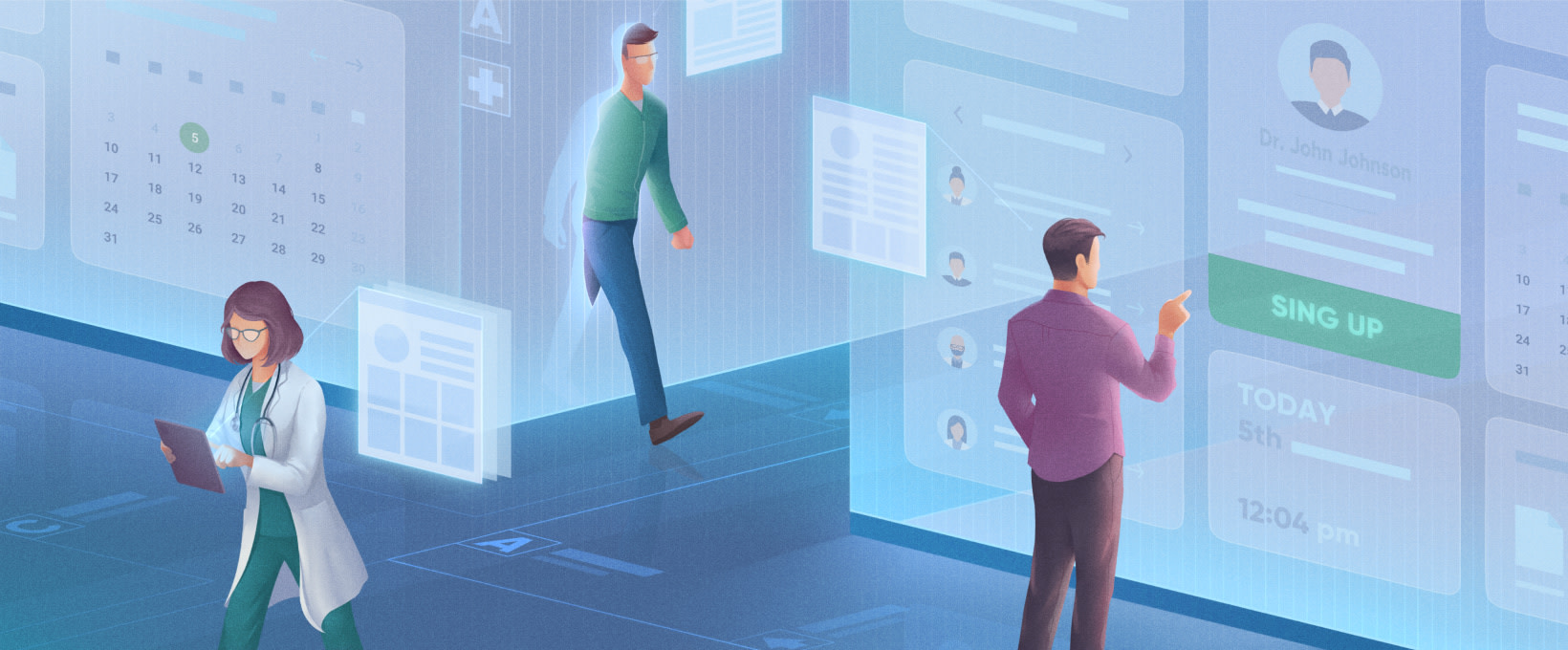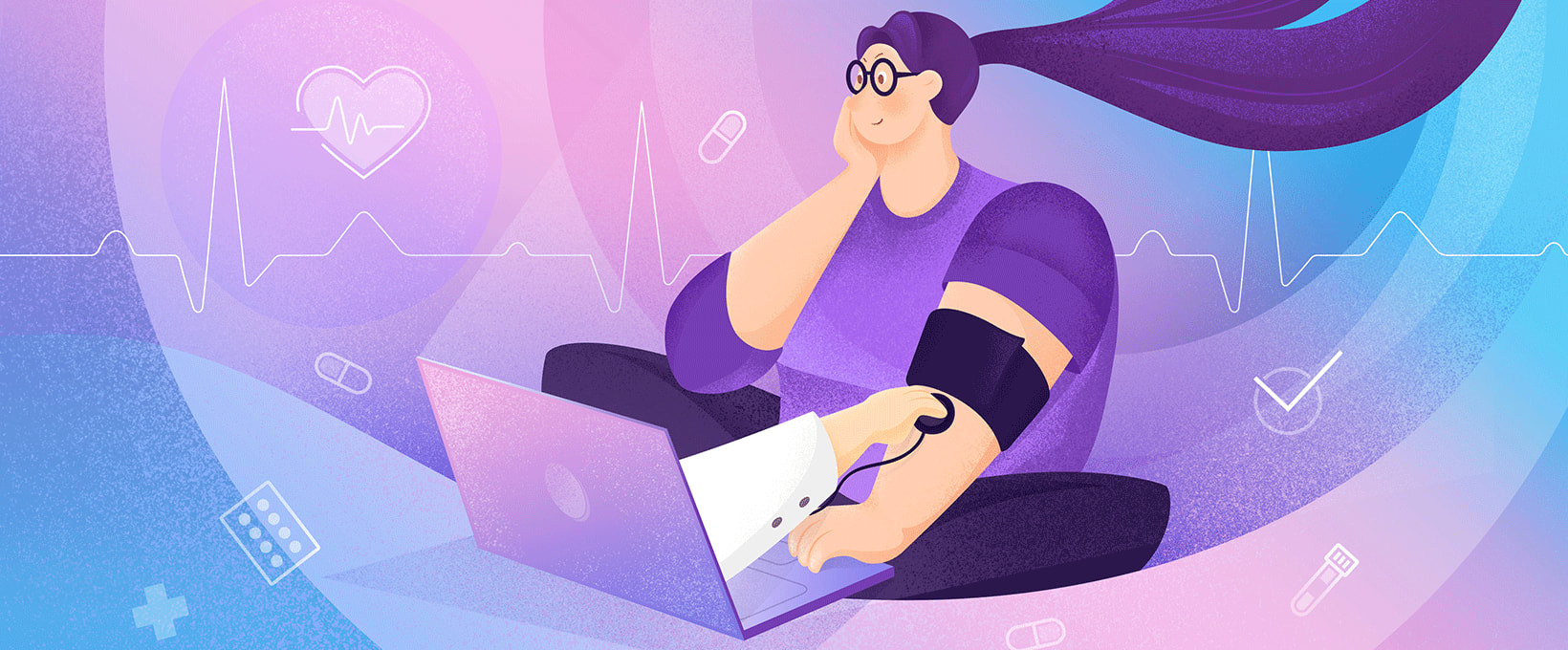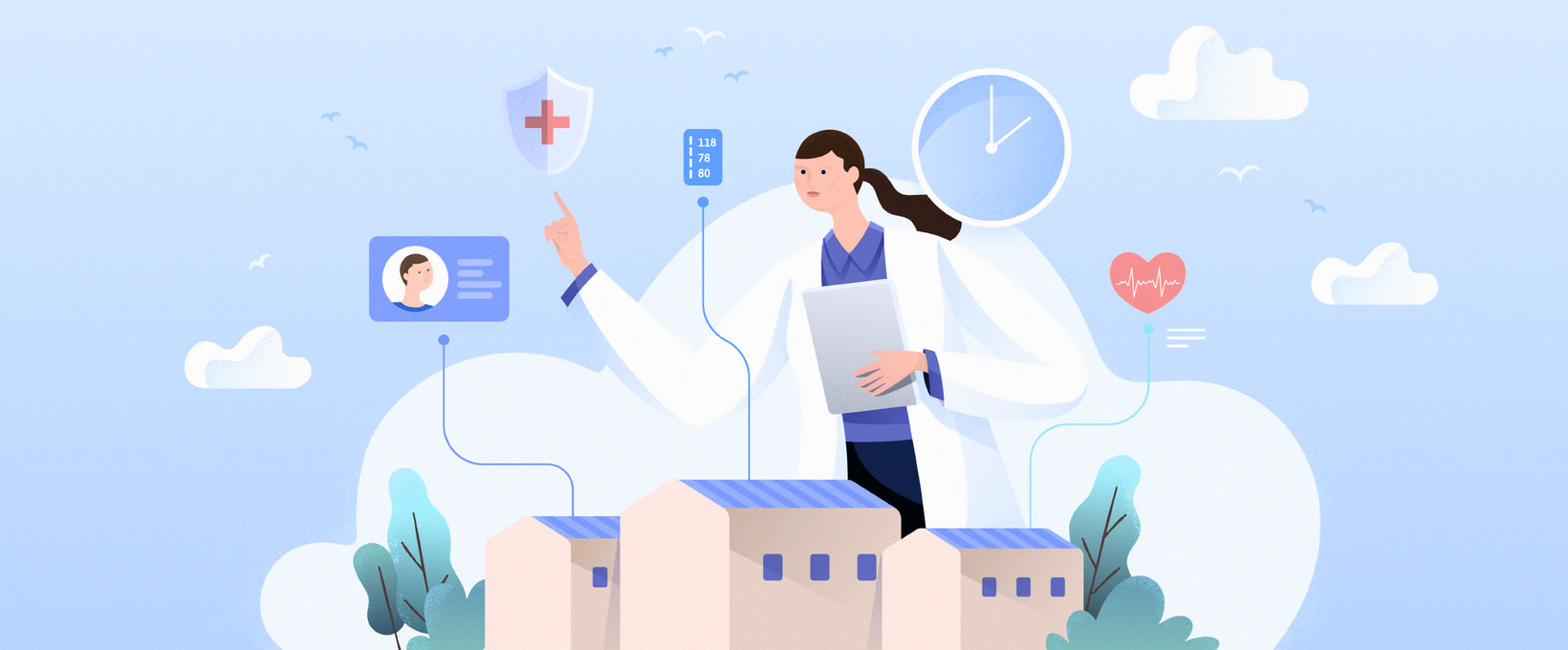- Why should your clinic go for the EHR implementation process?
- The clear-cut benefits of EHR implementation
- A surefire EHR implementation guide to go by
- Settling on the fundamental approach
- Determining the scope of your EHR implementation plan
- Conducting a discovery phase
- Carrying out the engineering part
- EHR system implementation
- Feedback and support
- EHR implementation best practices to consider
- Lean on a tailored-fit implementation strategy
- Allocate funds to comprehensive training
- Go for the staged implementation approach
- Get right on robust support and maintenance
- Give consideration to in-depth evaluation and feedback
- To sum up
The evolution of patient health records spans from ancient Egyptian yellowish parchments to the contemporary digital format displayed on a tablet screen. Today, electronic medical records, or EMRs, and electronic health records, or EHRs, as a broader concept are indispensable in the realm of contemporary healthcare. In this piece, we are providing the essential EHR implementation guide to determine the optimal way to seamlessly integrate the system with a clinic’s infrastructure. If you’re curious to learn more, read on!
Why should your clinic go for the EHR implementation process?
EHRs are used to guide individuals through recording, storage, and management of patients’ health information. This functionality can be enhanced by carefully fulfilling a thoroughly elaborated EHR implementation plan and integrating the technology with diverse health information systems, platforms, and devices. Consequently, duly authorized personnel gain instant entry to comprehensive patient case records, test outcomes, medical backgrounds, scheduled appointments, prescribed medications, and other pertinent data.
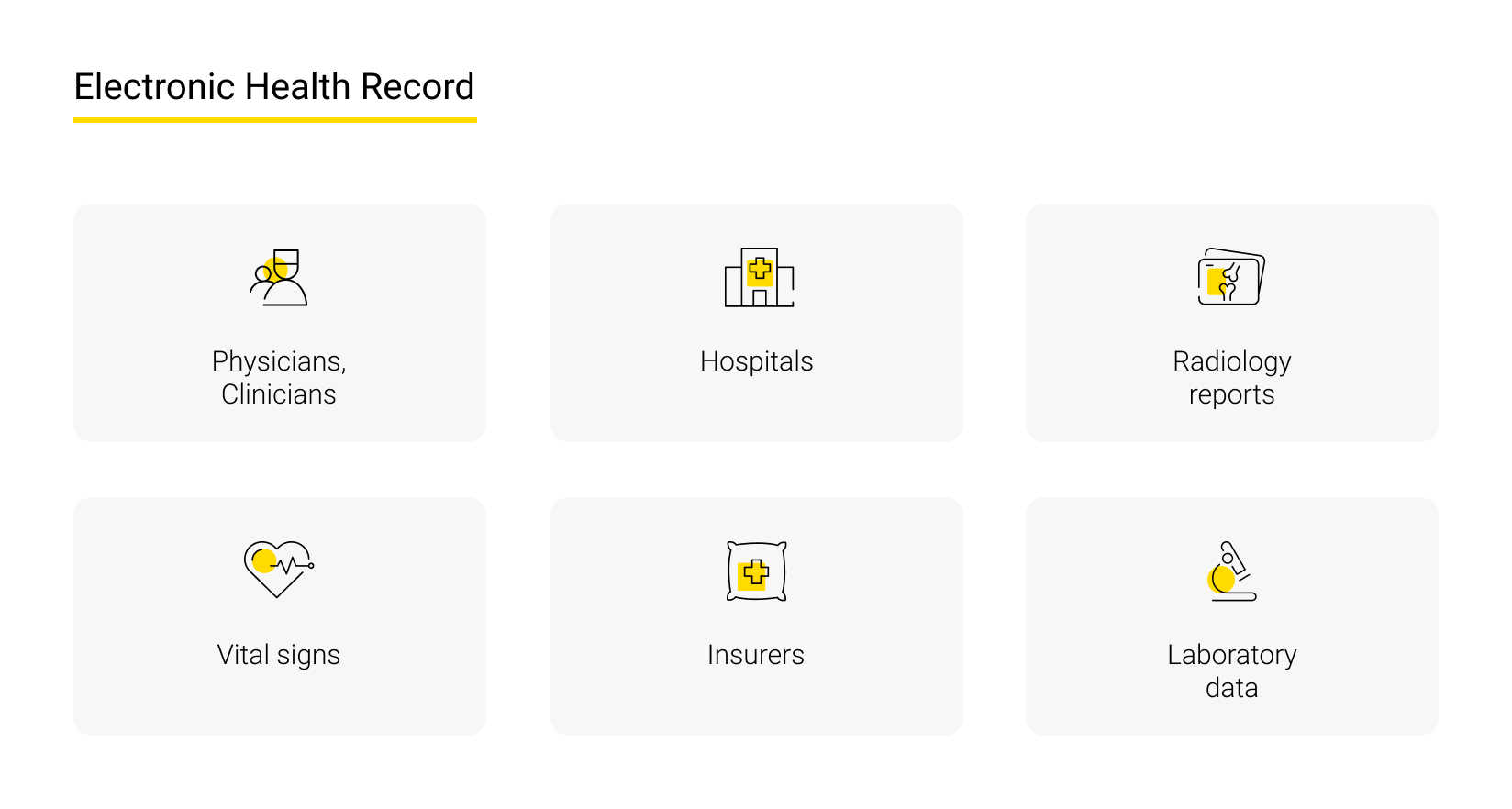
EHR software also serves to guide operational processes within healthcare institutions. It streamlines the management of clinical documentation and facilitates the reporting of information. When integrated with additional cutting-edge solutions such as Real-Time Location Systems, telehealth programs, Blockchain applications in healthcare, and so on, it enables professionals to smoothly monitor the availability of wards and beds, guide clinical procedures such as admissions and discharges, follow up with patients, track their vital indicators in the intervals between appointments, and much more.
Additionally, patients consistently retain access to their crucial health data via patient portals linked to these platforms. In this fashion, they gain enhanced awareness of their health status as they can easily view their lab results, medical images, prescribed medications, and details about insurance coverage. Consequently, patients achieve improved medication adherence and receive medical provider’s instructions promptly.
The clear-cut benefits of EHR implementation
In its guide, the US Office of the National Coordinator for Health Information Technology (ONC) lists the following benefits of implementing an EHR system that tip the balance when moving from the traditional paper-based document workflow:
-
The accessibility of data. Patients’ medical information is comprehensive, precise, and readily accessible to guide various practitioners and consultants round-the-clock, which promotes more organized and effective activities.
-
Improved and confidential engagement and communication between a patient and a provider. Exclusive access rights are granted solely to authorized users for viewing, using, and sharing patients' information. Patients have better access to care while providers can easily create and guide patients through referrals and e-prescriptions, as well as exchange images and lab results. This guarantees highly synchronized and comprehensive care delivery and boosts other related innovative approaches to caregiving, e.g. telehealth, which will inevitably increase your clinic’s telemedicine market share.
-
Improved providers’ productivity through the optimization of clinical workflows. Among the benefits of EHR implementation is the automation of operational processes, which results in improved scheduling for both patients and staff, more efficient medical coding and billing processes, an enhanced work-life balance for providers, and lowered care expenditures.
-
Increased safety for patients. Elevated safety measures for patients. Precision in personal identification facilitates more accurate medication prescribing, diminishes the likelihood of medical errors, and enhances decision-making through the integration of a clinical decision support guide embedded in the program.
EHR system implementation can proficiently guide the common practices of general hospitals and dental clinics. The system has turned out to be extremely useful during the pandemic outbreak when temporary facilities needed to be set up in a matter of days. Perhaps one of the most impressive examples of EHR effectiveness is the successful vaccination campaign in Israel, where the remarkably high vaccination rate was achieved rapidly thanks to the effective health information system covering each and every provider and all of the country’s residents. This allowed Israeli health authorities to swiftly establish the prioritization of vaccination and guide it effectively.
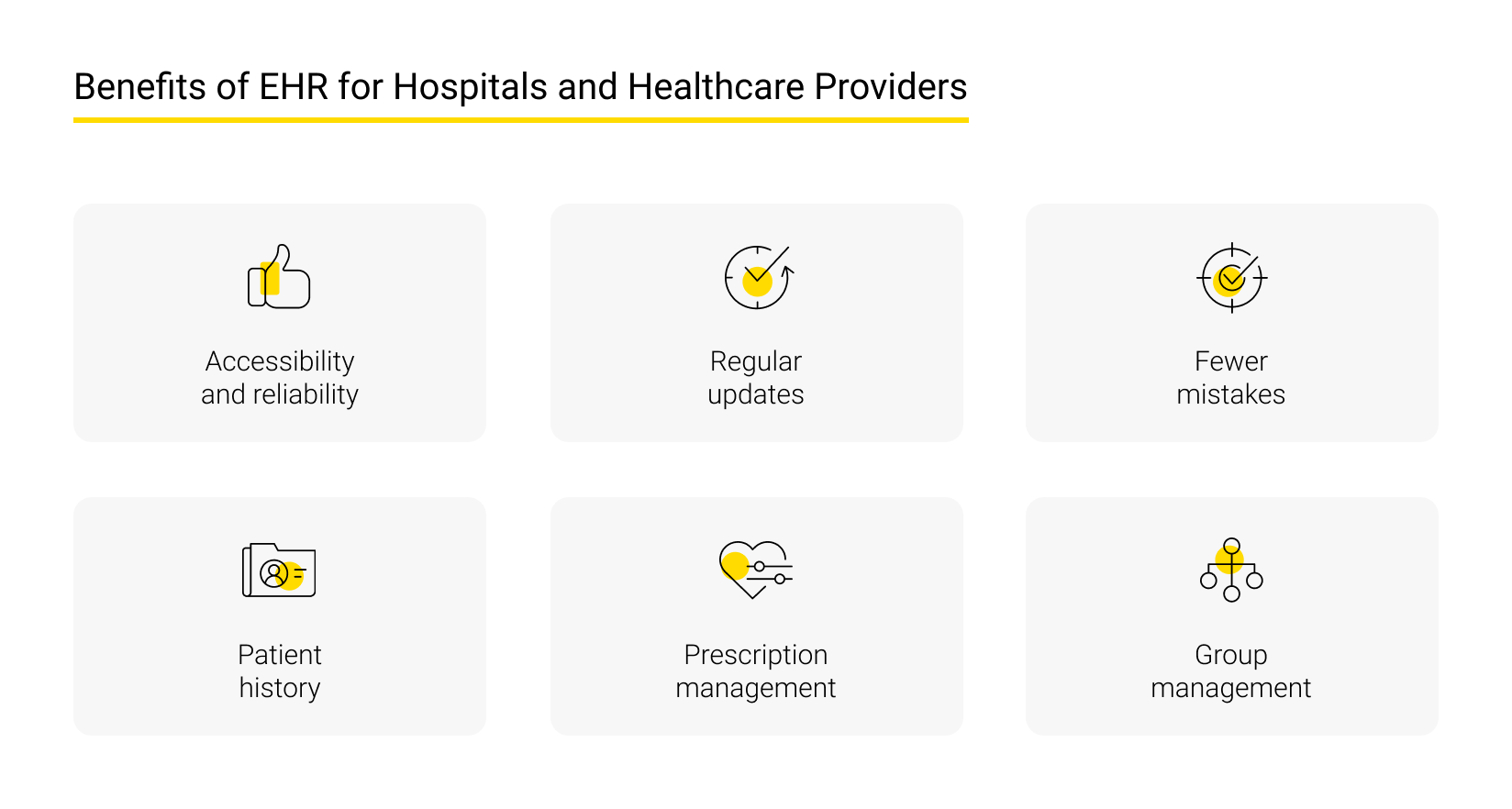
A surefire EHR implementation guide to go by
The following EHR implementation steps should guide the development and implementation of the system.
Settling on the fundamental approach
Responsible healthcare executives have the option to decide between procuring and customizing a pre-packaged solution or developing their own. In the former scenario, the implementation of the system might be quicker and upfront outlays could be reduced. However, not all features are adaptable, and the expenses associated with customizing them can be substantial. On the flip side, the majority of practices don’t need the richness of features that come with an off-the-shelf product.

Yet another significant consideration is the less-than-ideal usability and user experience offered by some off-the-shelf solutions, potentially contributing to a provider’s burnout. Additionally, the interoperability of an EHR system remains a lingering challenge.
Considering these challenges, a viable option could involve seeking assistance from professionals who’ll guide the creation of a bespoke program from scratch. Some of the perks of this approach include:
- complete and customized set of features that is akin to a meticulously tailored suit, cut and stitched to perfection, and is smoothly aligned with the intricate needs and flows of a care practice,
- a very intuitive and aesthetically pleasing UI and UX design to guide the firm through the rapid implementation of the system and guarantee enhanced end-user satisfaction,
- an array of integrations tailored to the practice’s needs to guide seamless synergy with any external and in-house technology that the business leans on,
- robust security protocols that are inherently woven into the architecture from the onset,
- lower support costs that stem from the fact that the system is precisely tuned to the organization's rhythms, and thus, downtimes are drastically decreased and reliability is boosted.
The main disadvantage of EHR software development from scratch is its higher cost and longer implementation time.
Determining the scope of your EHR implementation plan
The implementation of extraneous features makes it more difficult to guide an IT initiative because of the increased complexity and outlays. This underscores the importance of clearly delineating your business requirements and the processes slated for automation. Factors such as the facility's location and patient load are also critical considerations.
The cost fluctuates based on the intricacy of their features and integrations, project timelines, and various other factors. Choosing a custom solution prompts the vendor's presale team to assess your needs and guide you through a comprehensive plan outlining the engineering steps.
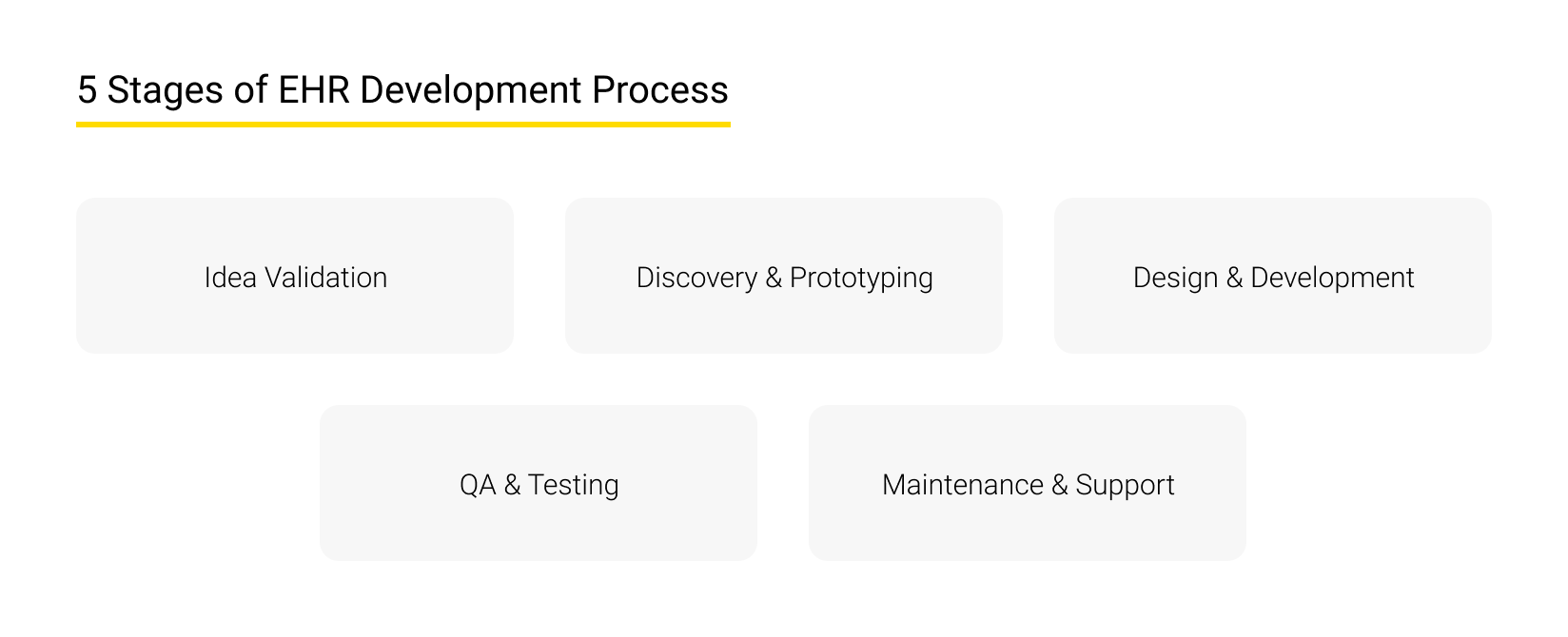
Conducting a discovery phase
During this brief stage that normally lasts from four to eight weeks, your EHR software development company of choice collects essential information concerning a customer's business needs, end-user profiles, system requirements, and other pertinent details in order to guide the creation of the future custom product precisely. In intricate IT products like EHR technology, the discovery phase saves resources needed for engineering.
Upon completing this stage, a technology company presents the envisioned future product and a scope document, architecture diagrams, initial backlog, requirement specification (SRS), a test guide, and design documentation, i.e. design concept, wireframes, and prototypes. In the course of the discovery phase, cooperation with the customer is very important as it is essential to capture the workflow in a healthcare institution and receive exhaustive feedback from major stakeholders.
Carrying out the engineering part
When the previously described phase is over and the vision of the future custom product is well-elaborated, the coding stage starts. Its average timeline is from six to eighteen months. The engineering part is usually performed by an experienced team of skilled developers according to the Agile methodology and involves close cooperation with representatives of the customer who is the product owner.
Needless to say, custom EHR programs must adhere to patient data security standards and requirements, e.g. GDPR, HIPAA, HITECH, and others, and, in most cases, should be certified accordingly. For instance, ONC Health IT Certification is essential to guide the US market.
A state-of-the-art system must be integrated with various health information components like patient portals, practice management systems, PACS for medical imaging, laboratory information systems, and clinical decision support systems. Also, it is crucial to integrate your EHRs with remote patient monitoring devices, drug databases, e-prescription services, clearinghouses, insurance companies, and payment modules.

EHR system implementation
The introduction of a newly-built program into a clinic’s workflow involves several stages. The facility managers need to form an implementation group that will guide the staff when adapting to the new platform. This team should include tech-savvy personnel that will guide the progress and communicate arising issues to the developers. Another stage is to appoint or hire specialists who will guide the transfer of documentation from hard copy to electronic format.
As studies show, proper training on the newly introduced system is the greatest predictor of clinical staff satisfaction with the new solution. Usually, the introduction of a new platform into a clinic’s workflow takes from three to six weeks. An ongoing training guide is also indispensable as new employees must be properly trained to use EHRs. Encouraging proficient users, including nurses and doctors, to guide their colleagues and share their experience during staff meetings and refresher training sessions is considered good practice.
Feedback and support
Engaging professional engineering services ensures continuous tech support after the launch of the EHR system. It's equally vital to empower health workers to provide reviews of the system, facilitating ongoing improvements and customization to meet the specific requirements of each team.
EHR implementation best practices to consider
Navigating the intricate pathway of EHR system implementation is akin to traversing a tightrope. It’s fraught with challenges, but with a trusted tech firm who will guide you through careful planning, precise execution, and continual monitoring, this journey will lead to enhanced care delivery, improved patient satisfaction, and operational excellence.
Here are some bespoke EHR implementation best practices and strategies to ensure the rewarding rollout of your system:
Lean on a tailored-fit implementation strategy
Every institution operates uniquely. Creating a tailored implementation plan that aligns with your organization’s niche-specific goals, workflow, and scale is paramount. Engage all relevant stakeholders, from care providers to administrative staff, to ensure the plan is robust, realistic, and comprehensive.
Allocate funds to comprehensive training
A common hurdle in the implementation of any new tech is the lack of adequate training. To successfully avoid these complications, make sure to invest time and resources in exhaustive training sessions. Thus, you can ensure that every user has mastered the new system in full. Training should be ongoing to accommodate updates, enhancing the user experience and ensuring optimal utilization of the system.
Go for the staged implementation approach
Avoid the pitfalls of rushed and incomplete implementation by adopting a phased approach. Break down the EHR implementation process into manageable parts, allowing ample time for each stage. This approach not only minimizes disruptions but also facilitates smoother integration, providing opportunities to rapidly address any unfolding complications.
Get right on robust support and maintenance
Provide immediate and continuous support to all users to address emerging concerns, troubleshoot issues, and offer guidance. A dedicated support team guarantees that problems are rapidly and accurately resolved, ensuring the uninterrupted operation of the system and ultimately contributing to enhanced patient care and operational efficiency.
Give consideration to in-depth evaluation and feedback
Incorporate solid mechanisms for detailed evaluation and continuous feedback within the implementation process. Regular assessments ensure the system is operating optimally and meets organizational objectives. Constructive user feedback, in turn, aids in making necessary adjustments and fostering the continual enhancement of the system.
To sum up
EHR is a cutting-edge technology that enhances medical care, on the one hand, and is a demanding challenge, on the other hand. Concerns about data security, interoperability, and product usability still warrant careful consideration. Nevertheless, a well-built and smoothly implemented platform significantly aids in streamlining a facility's routine processes, thereby enhancing efficiency and the quality of care provided.
For the last sixteen years, Andersen’s accomplished teams have been honing their tailored-fit tech solutions. We boast extensive experience and a proven track record in the industry and thus, know how to elaborate a winning healthcare app strategy for a project of any complexity and guide the creation of second-to-none apps. If you’re interested in working with us, reach out to our experts for a healthcare IT consultation to draw up a complete EHR implementation guide and discuss the optimal opportunities for your business.
